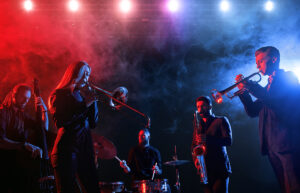What is K-Pop Music: Meaning, History, Characteristics, Impact, Songs & Bands

Welcome to the vibrant world of K-pop, where infectious beats, stunning choreography, and captivating melodies collide to create a global phenomenon.
In this comprehensive guide, we’ll embark on an exhilarating journey to unravel the enigma behind what is K-pop music, K-pop’s rise to stardom, exploring its origins, evolution and the sheer dedication of its passionate fandom. Get ready to groove to the rhythm of this cultural sensation and dive deep into what makes K-pop an irresistible force in today’s music landscape.
Welcome to TheDemoStop, now join the community!
Connect with artists, fans and producers around the world.
What is K-pop music?
K-pop, short for “Korean pop music,” originates from South Korea and encompasses a genre that blends various musical styles like pop, hip-hop, R&B, and EDM. Renowned for its catchy tunes, intricate choreography, and visually captivating music videos, K-pop has garnered global acclaim and become a sensation worldwide.
K-pop idols, who are rigorously trained performers, undergo extensive training in singing, dancing, and entertainment skills before debuting in groups. This rigorous preparation ensures that they are polished and proficient in various aspects of performance, including stage presence, vocal technique, choreography, and overall entertainment value.
A brief history of K-pop music
First generation K-pop (’90s-’00s)
In the ’90s, the foundation of K-pop was laid with the emergence of groups like Seo Taiji and Boys, who introduced a new sound blending Western pop, hip-hop, and R&B influences. This era established the modern K-pop idol system, characterized by groups like HOT, Sechs Kies, and SES. Their catchy music played a pivotal role in shaping the industry’s early identity, marking the beginning of a global phenomenon.
Second generation K-pop (’00s-’10s)
The second generation witnessed an explosion in K-pop’s popularity, marked by groups like TVXQ, Super Junior, Girls’ Generation, and BIGBANG. This period saw K-pop’s global expansion, fueled by social media and online platforms. K-pop began incorporating more diverse musical styles, intricate choreography, and high-quality production.
Third generation K-pop (’10s-Present)
The third generation of K-pop cemented its status as a global cultural phenomenon, with groups like BTS, EXO, BLACKPINK, TWICE, and Red Velvet achieving unprecedented success worldwide. This era emphasized storytelling through music, addressing social issues, and breaking language barriers. It solidified what is K-pop music and its position as a dominant force in the global music industry, transcending borders and captivating audiences worldwide.
Characteristics of K-pop music
The following characteristics define what is K-pop music and explain why it has become a global phenomenon today.
Idol culture
K-pop is closely associated with an idol culture where performers, known as idols, are carefully selected and trained extensively by entertainment agencies in singing, dancing, and sometimes acting or other skills.
Musical technicalities
K-pop’s production emphasizes high-quality sound engineering, intricate arrangements, and polished production values. The music showcases a blend of genres such as pop, hip-hop, R&B, EDM, rock, and more, often incorporating innovative sound elements to create a distinct sonic experience.
Intensive training
Idols undergo years of rigorous training in vocalization, dance routines, stage presence, languages, and even media handling before making their debut. This intensive grooming ensures a high level of performance and professionalism. All members of this industry are expected to go through this rigorous training.
A blend of different genres
K-pop seamlessly blends various musical genres to create a unique and captivating sound that appeals to a diverse audience. It’s not uncommon to find a single song incorporating elements from multiple genres, creating a dynamic and fresh musical fusion.
Catchy melodies and hooks
K-pop is renowned for its infectious and catchy tunes that often feature memorable hooks and choruses. These melodies are designed to be instantly appealing and linger in the listener’s mind.
Use of powerful choreography
Dance is a fundamental aspect of K-pop performances. Choreography is meticulously crafted, often characterized by precise synchronization, elaborate routines, and visually captivating movements that enhance the overall stage presence and entertainment value.
Multilingual lyrics
In a bid to appeal to a global audience, k-pop often features lyrics in multiple languages, predominantly Korean, English, and occasionally other languages. This multilingual approach helps in connecting with diverse fans worldwide and breaking language barriers.
K-pop music subgenre
Rap
Rap in K-pop involves incorporating elements of hip-hop and rap music styles into K-pop songs. Some K-pop groups or soloists feature rap sections within their songs, often delivered by specific members of the group who specialize in rapping. This style adds a dynamic element to the music contributing to the diversity of K-pop compositions and extensifies what is K-pop music.
Pop music
Pop music forms the core of K-pop. It encompasses a wide array of styles within the pop genre, blending catchy melodies, upbeat rhythms, and vibrant arrangements.
Rock
While not as prevalent as pop in K-pop, the rock subgenre occasionally finds its place within the industry. Some groups infuse rock elements into their music, incorporating electric guitar riffs, powerful vocals, and energetic rhythms.
Welcome to TheDemoStop, now join the community!
Connect with artists, fans and producers around the world.
Reggae
Reggae influences occasionally surface in K-pop songs, introducing elements like offbeat rhythms, syncopated accents, and reggae-style instrumentation. Though less common, when utilized, these reggae elements add a unique flair to K-pop tracks, diversifying the genre’s sound palette.
Trap music
In recent years, K-pop has incorporated trap music elements into its repertoire. This subgenre often features distinctive hi-hat rolls, heavy basslines, and rhythmic patterns characteristic of trap music.
Why is K-pop so popular?
Catchy melodies
K-pop often features catchy hooks and choruses that stick in the listener’s mind, making the songs instantly appealing and easy to remember.
Intense choreography
Elaborate and synchronized dance routines are a hallmark of K-pop performances. The visually stunning choreography, combined with the music, creates captivating stage performances that entertain audiences and leave a lasting impression.
Fashion
K-pop’s distinctive and diverse fashion choices, both on and off stage, influence global fashion trends, attracting attention and admiration from fans who appreciate their bold and innovative styles.
Simple lyrics
K-pop often utilizes simple and repetitive lyrics, making the songs accessible to a wide audience, including international listeners who might not understand the Korean language.
Multilingual songs
The inclusion of multiple languages, especially English, in K-pop songs appeals to a global audience. This multilingual approach enables fans worldwide to connect with the music on a deeper level, fostering a sense of inclusivity and connection.
Extremely dedicated fans
K-pop fandom, known for their passionate and dedicated support, plays a significant role in the genre’s popularity. These devoted fans actively promote their favorite artists on social media, attend concerts, buy merchandise, and create a strong sense of community, contributing immensely to K-pop artists’ global success and visibility.
Impact of K-pop music
Global popularity
K-pop’s infectious tunes, captivating performances, and dedicated fanbase have propelled its popularity worldwide. The gene’s appeal transcends borders, reaching audiences across continents and contributing to its status as a global music phenomenon.
Soft power and cultural influence
K-pop serves as a powerful tool for South Korea’s soft power diplomacy. The cultural influence of K-pop extends beyond music, shaping perceptions of South Korean culture, fashion, beauty, and lifestyle on a global scale.
Economic impact
The industry generates revenue through album sales, merchandise, concerts, endorsements, and tourism. K-pop’s influence boosts South Korea’s economy, contributing to its entertainment industry’s growth and creating employment opportunities within and outside the country.
Social media and internet presence
K-pop artists and fandom are highly active on social media platforms, leveraging the internet’s power to connect with fans globally. They utilize social media to communicate, promote, and engage, fostering a close bond between artists and their fanbase while maintaining a strong online presence.
Global recognition
K-pop’s international success has led to increased recognition and acceptance in the global music industry. K-pop artists collaborate with international artists, receive nominations and awards at prestigious music ceremonies, and feature prominently on global music charts.
K-pop group roles
Leader
The leader of a K-pop group is responsible for guiding and coordinating the group. They often act as spokespersons, mediate within the group, provide support, and represent the group in various activities.
Visual
The visual members play a crucial role in attracting attention through their aesthetics and visuals. They contribute to the group’s overall image, participate in promotional activities, and enhance the essence of what is K-pop music.
Maknae
The maknae is the youngest member of the group. Despite their age, they often display talents and maturity alongside a playful or endearing personality.
Main vocalist
The main vocalist is known for their exceptional vocal abilities. They lead and anchor the group’s vocal performances with their powerful or melodious singing skills.
Main rapper
The main rapper is responsible for delivering rap verses in the group’s songs. They showcase strong lyrical delivery, flow, and often contribute to the group’s overall style by infusing rap elements into the music.
Main dancer
The main dancer stands out for their exceptional dancing abilities. They lead the group’s choreography, showcasing precision, agility, and charisma in their dance performances.
Welcome to TheDemoStop, now join the community!
Connect with artists, fans and producers around the world.
Famous K-pop songs
“Gangnam Style” by PSY
Released in 2012, “Gangnam Style” became a global sensation, making K-pop a household name worldwide. Its catchy tune, iconic dance moves, and humorous music video featuring PSY propelled it to become the first YouTube music video to reach a billion views.
“Butter” by BTS
“Butter” is a dynamic and catchy song by BTS that dominated the charts globally upon its release in 2021. It’s known for its smooth vocals, upbeat rhythm, and charismatic performance, breaking multiple records and maintaining a strong presence on international music charts.
“How You Like That” by BLACKPINK
Released in 2020, “How You Like That” showcased BLACKPINK’s powerful vocals, striking visuals, and energetic choreography.
“I Will Go to You Like the First Snow” by Ailee
This emotional ballad by Aille was part of the soundtrack for the Korean drama “Goblin.” Known for its beautiful melody and Ailee’s powerful vocals, the song became immensely popular, capturing the emotions of love and longing.
“Red Flavor” by Red Velvet
“Red Flavor” is an upbeat and vibrant song by Red Velvet that captivated audiences with its catchy chorus, lively melody, and colorful music video. It became a summer anthem upon its release in 2017, showcasing the group’s energetic and playful style.
“Dynamite” by BTS
“Dynamite” marked BTS’s first English-language single, which was released in 2020. Its infectious disco-pop vibe, feel-good lyrics, and vibrant performance made it a global hit, topping charts worldwide and earning critical acclaim.
“Bang Bang Bang” by BIGBANG
“Bang Bang Bang” is an energetic and powerful song by BIGBANG, known for its addictive beat, catchy chorus, and high-energy music video. Released in 2015, it became a massive hit in South Korea and internationally.
“Cheer Up” by TWICE
“Cheer Up” by TWICE is an upbeat and catchy song that propelled the group to stardom upon its release in 2016. With its catchy hook, lively choreography, and charming concept, the song became a massive hit in South Korea, solidifying TWICE’s popularity.
Top K-pop bands
BTS
BTS, short for Bangtan Sonyeondan, is a globally acclaimed boy band known for their exceptional music, thought-provoking lyrics, and dynamic performances. They’ve achieved immense success, breaking numerous records, and have become global ambassadors for introducing more people to what is K-pop music.
BLACKPINK
BLACKPINK is a popular girl group renowned for their powerful performances, stylish concepts, and international appeal. They’ve captivated audiences with their catchy songs, impactful choreography, and strong visual presence.
EXO
EXO is a versatile and talented boy band recognized for their diverse music styles, impressive vocals, and synchronized choreography. They’ve gained recognition for their strong stage presence and have a massive fan following.
Wonder Girls
Wonder Girl, one of the pioneering K-pop girl groups, gained popularity for their catchy hits and retro-inspired music. They’ve made significant contributions to K-pop’s international recognition and have been influential in shaping the industry.
Big Bang
Big Bang is a legendary boy band known for their innovation, creativity, and groundbreaking music. They’ve left a lasting impact on K-pop, paving the way for future generations with their distinct style, versatility, and chart-topping hits.
Red Velvet
Red Velvet is a versatile girl group celebrated for their unique concepts, diverse music styles, and strong vocal performances. They’ve showcased their versatility through various musical genres and have a dedicated fanbase worldwide.
TWICE
TWICE is a popular girl group known for their catchy tunes, cheerful concepts, and engaging performances. They’ve gained immense popularity both in South Korea and internationally, becoming one of the leading girl groups in the K-pop industry.
Welcome to TheDemoStop, now join the community!
Connect with artists, fans and producers around the world.
Conclusion
What is K-pop music?
K-pop stands for Korean pop music, a dynamic music genre from South Korea known for its catchy melodies, intricate choreography, diverse musical influences, and meticulously trained performers called idols.
Brief history of K-pop music
- First generation K-pop (’90s- ’00s)
- Second generation K-pop (’00s- ’10s)
- Third generation K-pop (’10s- ’20s)
Characteristics of K-pop music
- Idol culture
- Musical technicalities
- Intensive training
- A blend of different genres
- Catchy melodies and hooks
- Use of powerful choreography
- Multilingual lyrics
K-pop music subgenres
- Rap
- Pop music
- Rock
- Reggae
- Trap music
Why is K-pop so popular?
- Catchy melodies
- Intense choreography
- Fashion
- Simple lyrics
- Multilingual songs
- Extremely dedicated songs
Impact of K-pop music
- Global popularity
- Soft power and cultural influences
- Economic impact
- Social media and internet presence
- Global recognition
K-pop group roles
- Leader
- Visual
- Maknae
- Main vocalist
- Main rapper
- Main dancer
Famous K-pop songs
- “Gangnam Style” by PSY
- “Butter” by BTS
- “How You Like That” by BLACKPINK
- “I Will Go to You Like the First Snow” by Ailee
- “Red Flavor” by Red Velvet
- “Dynamite” by BTS
- “Bang Bang Bang” by BIGBANG
- “Cheer Up” by TWICE
Top K-pop bands
- BTS
- BLACKPINK
- EXO
- Wonder Girls
- BIGBANG
- Red Velvet
- TWICE
FAQs
What defines K-pop music?
K-pop music is defined by its fusion of catchy melodies, intricate choreography, visually captivating performances, diverse musical influences, meticulously trained idols, and a dedicated global fanbase.
What are the characteristics of K-pop dance?
The characteristics of K-pop dance include precise and synchronized choreography, dynamic movements, intricate formations, energetic performances, and a fusion of various dance styles such as hip-hop, urban, contemporary, and traditional Korean dance elements.
What is the most popular K-pop subgenre?
The most popular K-pop subgenre is pop music, known for its catchy melodies, vibrant beats, and broad commercial appeal.
What are the subgenres of K-pop music?
- Rap
- Pop music
- Rock
- Reggae
- Trap music
What are the positions in a K-pop group?
- Leader
- Visual
- Maknae
- Main vocalist
- Main rapper
- Main dancer
What is the most important role in a k-pop group?
The most important role in a K-pop group can vary. Still, the leader often plays a crucial role in guiding the group, facilitating communication, and representing the group’s collective interests.
What is the most played K-pop song?
“Dynamite” by BTS is the most-played K-pop song.
When was K-pop most popular?
K-pop experienced significant global popularity and recognition in the late 2010s and continues to maintain its strong presence in the global music industry.
What are the top 5 most popular K-pop groups?
- BTS
- BLACKPINK
- EXO
- Wonder Girls
- BIGBANG
- Red Velvet
- TWICE
Which one is the most popular K-pop group?
BTS is one of the most popular K-pop groups worldwide.
Who is called the king of K-pop?
A prominent member of BTS, Jimin is known as the king of K-pop.
Which one is the richest K-pop group?
BTS is considered one of the wealthiest K-pop groups, having achieved immense commercial success and global popularity.
What does K-pop stand for?
K-pop stands for Korean pop music.































































